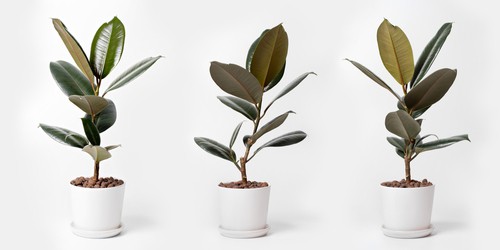Baby rubber plants are a popular choice for indoor gardeners due to their compact size and attractive foliage. However, it can be frustrating to see your baby rubber plant drooping and not thriving as it should.
There are several reasons why your baby rubber plant may be drooping, but with some care and attention, you can revive your plant and help it thrive.
Understanding why your baby rubber plant is drooping is the first step to nursing it back to health. Inadequate watering, humidity levels, and changes in temperature are common causes of drooping leaves in baby rubber plants.
Overwatering can also lead to drooping leaves, so it’s important to strike a balance between not watering too frequently and not leaving your plant without water for too long.
Caring for your baby rubber plant involves providing it with the right amount of water, light, and humidity. Addressing common rubber plant problems such as pests and diseases can also help prevent drooping leaves.
If your plant is already drooping, reviving it involves adjusting these factors to create the ideal growing conditions for your plant. Additional rubber plant care tips can help ensure your plant stays healthy and vibrant.
More on this category:
Understanding Rubber Plant Drooping
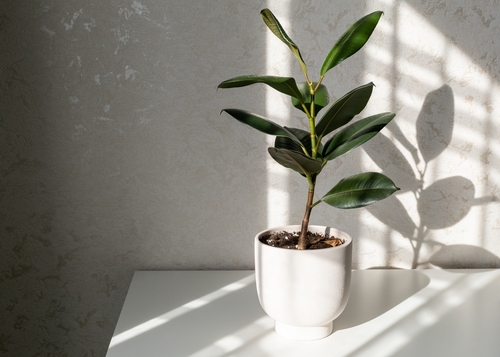
Rubber plants are a popular houseplant due to their attractive foliage and easy care requirements. However, sometimes these plants can start to droop, which can be a cause for concern for plant owners. In this section, we will discuss the most common reasons why a baby rubber plant may start to droop.
1. Overwatering and Underwatering
One of the most common reasons for a rubber plant to droop is overwatering or underwatering. Rubber plants prefer to be kept consistently moist, but not waterlogged. Overwatering can lead to root rot, which can cause the leaves to droop and turn yellow.
On the other hand, underwatering can cause the leaves to wilt and droop as well. It is important to find the right balance of watering for your rubber plant.
2. Temperature Changes
Rubber plants are sensitive to temperature changes and can start to droop if they are exposed to extreme temperatures. If the temperature drops too low, the leaves can start to wilt and droop.
Similarly, if the temperature is too high, the leaves can become scorched and start to droop. It is important to keep your rubber plant in a room with a consistent temperature and away from drafts.
3. Insufficient Light
Rubber plants require bright, indirect light to thrive. If a rubber plant is not getting enough light, it can start to droop and the leaves can turn yellow. It is important to place your rubber plant near a window that receives bright, indirect light for most of the day.
If your rubber plant is not getting enough light, consider moving it to a brighter location or supplementing its light with a grow light.
4. Pest Infestation
Rubber plants can be susceptible to pest infestations, such as spider mites and mealybugs. If a rubber plant is infested with pests, it can start to droop and the leaves can turn yellow. It is important to inspect your rubber plant regularly for signs of pests and to treat any infestations promptly.
Caring for Your Rubber Plant
When it comes to caring for your baby rubber plant, there are a few key factors to consider. The following sub-sections will cover the most important aspects of caring for your rubber plant.
1. Watering Needs

Watering is one of the most important aspects of caring for your rubber plant. Overwatering or underwatering can cause your plant to droop or even die. It’s important to find the right watering schedule for your plant.
As a general rule, you should water your rubber plant when the top inch of soil feels dry to the touch. Be sure to water thoroughly, allowing the excess water to drain out of the pot. Avoid letting your rubber plant sit in standing water, as this can lead to root rot.
2. Light Requirements
Rubber plants prefer bright, indirect light. They can tolerate some direct sunlight, but too much can scorch their leaves. If your rubber plant isn’t getting enough light, it may become leggy and droop.
If your rubber plant isn’t getting enough light, consider moving it to a brighter location. If it’s getting too much direct sunlight, move it to a shadier spot.
3. Temperature and Humidity
Rubber plants prefer temperatures between 60 and 75 degrees Fahrenheit. They also prefer high humidity. If the air in your home is dry, you may need to increase the humidity around your plant.
You can increase humidity by misting your plant with water, placing a humidifier near your plant, or placing a tray of water near your plant. Be sure to keep the water level in the tray below the level of the pot to avoid waterlogging your plant.
4. Fertilizing Your Plant
Fertilizing your rubber plant can help it grow strong and healthy. You should fertilize your plant every two to four weeks during the growing season (spring and summer).
Use a balanced, water-soluble fertilizer and follow the instructions on the package. Be sure not to over-fertilize, as this can lead to fertilizer burn.
Why Is My Baby Rubber Plant Drooping – 3 Common Problems
Rubber plants are generally easy to care for, but they can still suffer from a variety of common problems that can cause them to droop. This section will cover some of the most common issues that can cause a baby rubber plant to droop and how to address them.
1. Overwatering and Root Rot
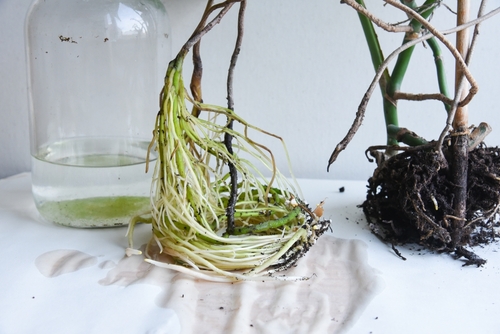
Overwatering is a common problem that can cause rubber plants to droop. When the soil is constantly wet, it can lead to root rot, which can be deadly to the plant. To prevent overwatering, make sure the plant is in a pot with good drainage and only water it when the top inch or two of soil is dry.
If you suspect root rot, remove the plant from the pot and inspect the roots. If they are brown and mushy, they have likely rotted and the plant will need to be repotted in fresh soil.
2. Pest and Disease Management
Rubber plants can be susceptible to a variety of pests and diseases, which can cause them to droop. Spider mites, mealybugs, and scale insects are common pests that can infest rubber plants.
To manage pests, use a gentle insecticidal soap or neem oil and wipe down the leaves with a damp cloth. Fungal diseases, such as powdery mildew and leaf spot, can also cause drooping. To prevent fungal infections, make sure the plant is not overcrowded and has good air circulation.
3. Light and Temperature Issues
Rubber plants require bright, indirect light to thrive. If they are not getting enough light, they can become leggy and droop. Make sure the plant is not in direct sunlight, as this can scorch the leaves.
Temperature changes can also cause drooping. Rubber plants prefer temperatures between 60 and 75 degrees Fahrenheit and can suffer if exposed to extreme temperatures. If the plant is near a drafty window or door, move it to a more stable location.
Reviving a Drooping Rubber Plant
If your baby rubber plant is drooping, don’t worry, there are ways to revive it. Here are some steps you can take to get your plant back to health.
1. Repotting and Pruning
One reason your rubber plant may be drooping is due to root-bound. If the roots have outgrown the pot, they may not be able to absorb enough water and nutrients, causing the leaves to droop. Repotting your plant can help solve this issue.
When repotting, choose a pot that is one size larger than the current one. Use a well-draining soil mixture that contains perlite or vermiculite to improve drainage. Remove the plant from its current pot, gently loosen the roots, and place it in the new pot. Fill in the empty spaces with fresh soil and give it a good watering.
Another reason for drooping leaves could be due to overgrowth. Pruning your rubber plant can help it recover by removing dead or damaged leaves and allowing new growth to emerge. Cut back any yellow or brown leaves, and trim back any long or leggy stems.
2. Addressing Shock
If your rubber plant has recently experienced a change in environment, such as a move to a new location or a change in temperature, it may be experiencing shock. This can cause the leaves to droop and the plant to wilt.
To address shock, provide your plant with a stable environment. Keep it away from drafts and direct sunlight, and maintain a consistent temperature and humidity level. You can also mist the leaves to help increase humidity levels.
3. Soil and Drainage Adjustments
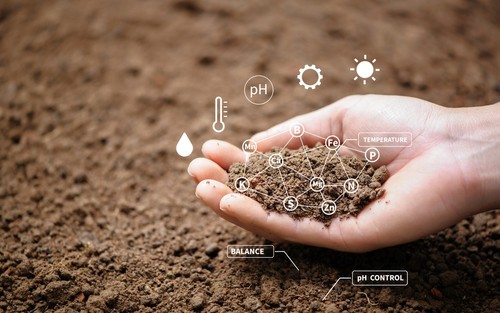
Overwatering or underwatering can also cause rubber plant leaves to droop. Check the soil moisture level by sticking your finger into the soil to a depth of about an inch. If the soil feels dry, it’s time to water your plant. If it feels moist, wait a few more days before watering.
To improve drainage, make sure your pot has drainage holes and use a well-draining soil mixture. You can also add perlite or vermiculite to the soil to help improve drainage.
Finally, make sure your rubber plant has a proper support system. If the stem is weak or drooping, use a stake or support to help it stand upright.
By following these steps, you can revive your drooping rubber plant and help it thrive again.
Additional Rubber Plant Care Tips
Rubber plants are a popular houseplant due to their attractive foliage and ease of care. However, sometimes they can start drooping, which may indicate that they are not receiving the proper care. Here are some additional care tips for rubber plants to keep them healthy and prevent drooping.
1. Propagation Tips
If you want to propagate your rubber plant, stem tip cuttings or division are the best methods. To propagate using stem tip cuttings, remove the top of a healthy stem with at least a couple of leaves on it and one node below the leaves. Place the cutting in a well-draining potting mix and keep it moist until roots develop.
2. Managing Indoor Conditions
Rubber plants prefer bright, indirect light, but they can also tolerate low light conditions. Keep them away from cold air and heating systems, as temperature fluctuations can cause stress and stunted growth.
Maintain a temperature between 60°F and 75°F and a humidity level between 40% and 60%. If the air in your home is dry, you can use a humidifier or place a pebble tray filled with water under the pot to increase humidity.
3. Choosing the Right Soil and Pot
Rubber plants prefer well-draining soil that is rich in organic matter. A mix of orchid bark, sand, and a good quality potting mix can provide the perfect growing medium.
It is important to choose a pot with drainage holes to prevent waterlogging, which can cause yellow leaves and edema. Repot your rubber plant every 2-3 years to prevent aging and promote growth.
Conclusion
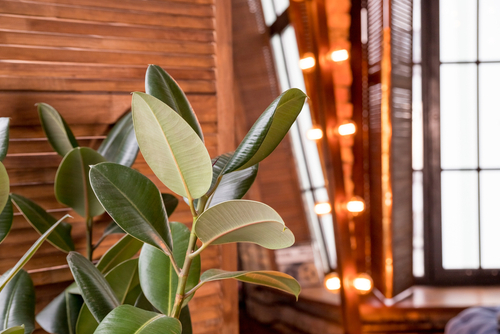
Drooping leaves in baby rubber plants can be a common issue for plant owners. The most common causes of drooping leaves in baby rubber plants are inadequate watering, humidity levels, and changes in temperature. It is important to maintain the right conditions to ensure that the baby rubber plant remains healthy and vibrant.
When it comes to watering, it is important to ensure that the plant is not left without water for more than 7 days. Overwatering can also cause the plant to droop, so it is important to strike a balance between the two.
Rubber plants are native to humid, tropical environments and thus prefer consistent moisture. If the plant is wilting and its leaves are drooping, it is likely due to underwatering. Rubber plants can go without water for a little while, but they will start to show signs of stress if they’re not watered regularly.
In addition to watering, humidity levels and changes in temperature can also cause drooping leaves in baby rubber plants. It is important to ensure that the plant is kept in a humid environment, as it can help prevent the leaves from drying out.
This can be achieved by placing a humidifier near the plant or by placing a tray of water near the plant. Changes in temperature can also cause the plant to droop, so it is important to keep the plant in a stable environment.
Frequently Asked Questions
How to fix drooping rubber plant?
If your baby rubber plant is drooping, the first thing to do is to check the soil moisture. Overwatering and underwatering are common causes of drooping rubber plants.
Make sure that the soil is not too dry or too wet. It is recommended to water the plant when the top 1-2 inches of soil feel dry. Also, ensure that the pot has good drainage to prevent waterlogging.
Another possible reason for drooping rubber plants is lack of sunlight. Rubber plants need bright, indirect light to thrive. If your plant is not getting enough light, move it to a brighter spot, but avoid direct sunlight that can scorch the leaves.
Rubber plant leaves drooping and falling off?
If the leaves of your rubber plant are drooping and falling off, it may be due to underwatering. When a rubber plant is not watered enough, it will start to shed leaves to conserve water.
To fix this issue, water the plant thoroughly and ensure that the soil is moist but not waterlogged.Another possible reason for leaves falling off is overwatering.
When a rubber plant is overwatered, the roots can become waterlogged and start to rot, leading to leaf drop. Check the soil moisture and adjust the watering frequency accordingly.
Rubber plant leaves drooping and curling?
If the leaves of your rubber plant are drooping and curling, it may be due to underwatering or overwatering. Check the soil moisture and adjust the watering frequency accordingly.
It is also possible that the plant is not getting enough humidity. Rubber plants prefer a humid environment, so misting the leaves or placing a humidifier nearby can help.
Rubber plant drooping stems?
If the stems of your rubber plant are drooping, it may be due to overwatering or lack of sunlight. Check the soil moisture and adjust the watering frequency accordingly. If the plant is not getting enough light, move it to a brighter spot.
Rubber plant leaves drooping after repotting?
It is normal for a rubber plant to experience some stress after repotting, which can cause drooping leaves. To help the plant recover, water it thoroughly and keep it in a shaded spot for a few days. Avoid fertilizing the plant for a few weeks after repotting.
How do you revive a droopy rubber plant?
To revive a droopy rubber plant, ensure that it is getting the right amount of water and sunlight. Check the soil moisture and adjust the watering frequency accordingly.
If the plant is not getting enough light, move it to a brighter spot. You can also prune any damaged or yellowing leaves to encourage new growth.

Hey, I’m Lisa and I’ve been an avid gardener for over 30 years. I love writing, talking and living in the garden! Feel free to connect with me on my socials below

